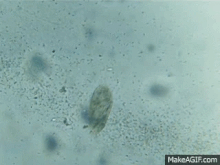Paramecium
See text Paramecium (/ˌpærəˈmiːs(i)əm/ PARR-ə-MEE-s(ee-)əm, /-siəm/ -see-əm, plural "paramecia" only when used as a vernacular name)[2] is a genus of eukaryotic, unicellular ciliates, widespread in freshwater, brackish, and marine environments.
Because some species are readily cultivated and easily induced to conjugate and divide, they have been widely used in classrooms and laboratories to study biological processes.
Paramecium species are commonly studied as model organisms of the ciliate group and have been characterized as the "white rats" of the phylum Ciliophora.
[5] In 1718, the French mathematics teacher and microscopist Louis Joblot published a description and illustration of a microscopic poisson (fish), which he discovered in an infusion of oak bark in water.
"[7] In 1773, O. F. Müller, the first researcher to place the genus within the Linnaean system of taxonomy, adopted the name Paramecium but changed the spelling to Paramæcium.
[9] C. G. Ehrenberg, in a major study of the infusoria published in 1838, restored Hill's original spelling for the name, and most researchers have followed his lead.
Between the alveolar sacs of the pellicle, most species of Paramecium have closely spaced spindle-shaped trichocysts, explosive organelles that discharge thin, non-toxic filaments, often used for defensive purposes.
[14] Osmoregulation is carried out by contractile vacuoles, which actively expel water from the cell to compensate for fluid absorbed by osmosis from its surroundings.
When it happens to encounter an obstacle, the "effective stroke" of its cilia is reversed and the organism swims backward for a brief time, before resuming its forward progress.
This low percentage is nevertheless close to the maximum theoretical efficiency that can be achieved by an organism equipped with cilia as short as those of the members of Paramecium.
To gather food, the Paramecium makes movements with cilia to sweep prey organisms, along with some water, through the oral groove (vestibulum, or vestibule), and into the cell.
[28] The question of whether Paramecium exhibit learning has been the object of a great deal of experimentation, yielding equivocal results.
However, a study published in 2006 seems to show that Paramecium caudatum may be trained, through the application of a 6.5 volt electric current, to discriminate between brightness levels.
Under certain conditions, it may be preceded by self-fertilization (autogamy),[33] or it may immediately follow conjugation, in which Paramecium of compatible mating types fuse temporarily and exchange genetic material.
In ciliates such as Paramecium, conjugation is a sexual phenomenon that results in genetic recombination and nuclear reorganization within the cell.
When clonally aged P. tetraurelia are stimulated to undergo meiosis in association with either conjugation or automixis, the genetic descendants are rejuvenated, and are able to have many more mitotic binary fission divisions.
[40] The CtlP and Mre11 nuclease complex are essential for accurate processing and repair of double-strand breaks during homologous recombination.
[41] This observation suggests that the underlying molecular mechanism of meiosis provides a fitness advantage regardless of any concomitant effect of sex on genetic diversity.





